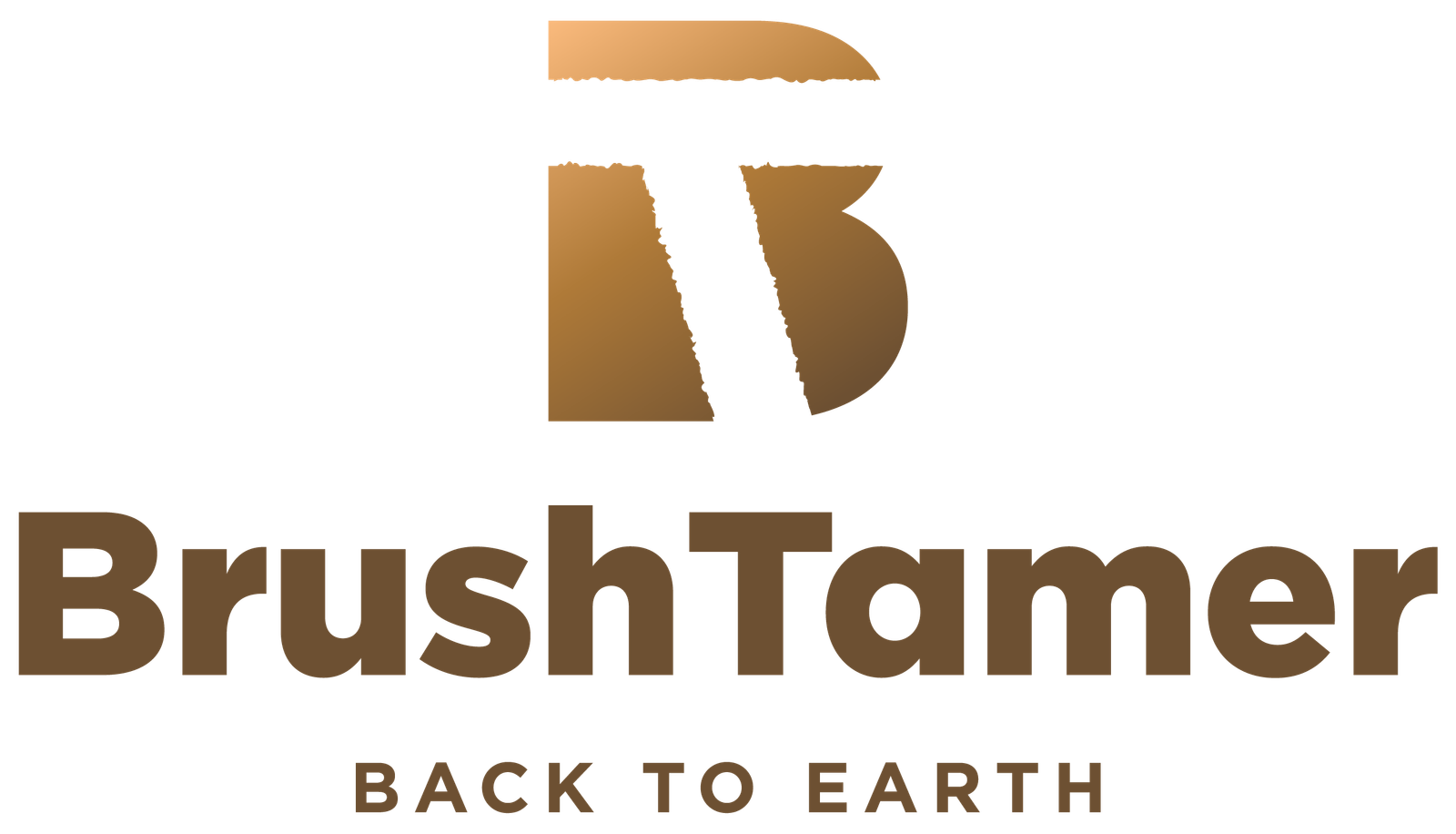Understanding the True Cost of Clearing Your Land
The lot clearing cost per acre is one of the most critical budget items for landowners planning a new project, whether it’s building a dream home, expanding a farm, or creating recreational space. For property owners in the Midwest, this cost typically ranges from as low as $500 for simple brush removal to as high as $5,600 or more for densely forested land. The final price tag is never a one-size-fits-all number; it’s a detailed calculation based on your property’s unique conditions and your ultimate goals.
Understanding this range is the first step toward creating a realistic budget. A simple project on flat, open land will naturally cost less than a complex one on a steep, rocky hillside covered in mature oak trees. The key is to look beyond a simple per-acre rate and consider the specific variables that will influence your project.
Quick Cost Overview:
- Lightly wooded lots (scattered small trees, brush): $580 – $2,100 per acre. This typically involves clearing saplings under 6 inches in diameter and dense undergrowth. The work is faster and can often be done with smaller, more agile equipment like a skid-steer with a mulching head.
- Heavily forested land (mature trees, dense canopy): $3,300 – $5,600 per acre. This involves removing large trees (over 12 inches in diameter), which requires heavy-duty equipment, more labor, and careful planning to fell trees safely. Stump removal is a major factor in this price range.
- Brush removal only (no significant trees): $330 – $630 per acre. This is for properties overgrown with shrubs, vines, and invasive species but without the need for felling trees. It’s often the first step in reclaiming pastureland or preparing a site for a garden.
- National average: $3,792 per acre. This figure serves as a general benchmark, but regional costs, especially in the Midwest, can vary based on local labor rates and disposal options.
This wide spectrum is a direct result of factors like vegetation density, terrain complexity, overall lot size, the chosen clearing method, and the plan for debris removal. For instance, a small, quarter-acre lot with only light brush might cost as little as $250. In contrast, a single, heavily forested acre that requires the removal of large stumps and extensive grading could easily exceed $7,000.
Furthermore, the initial clearing is often just one piece of the puzzle. Additional site preparation costs, such as grading the land for proper drainage, obtaining necessary permits, and conducting land surveys, can add another $200 to $2,000 per acre. It’s essential to factor these potential expenses into your initial budget to avoid surprises down the road. Understanding these variables is the key to accurately forecasting the investment required for your land change project.
I’m Leon Miller, owner of BrushTamer. With years of hands-on experience in forestry mulching and comprehensive project management across Indiana and the surrounding states, I’ve seen how a well-planned clearing project can open up a property’s true potential. The most cost-effective and successful approach always begins with a clear understanding of the land itself and the owner’s long-term vision. We’re here to help you steer those variables and find the right solution for your land and your budget.
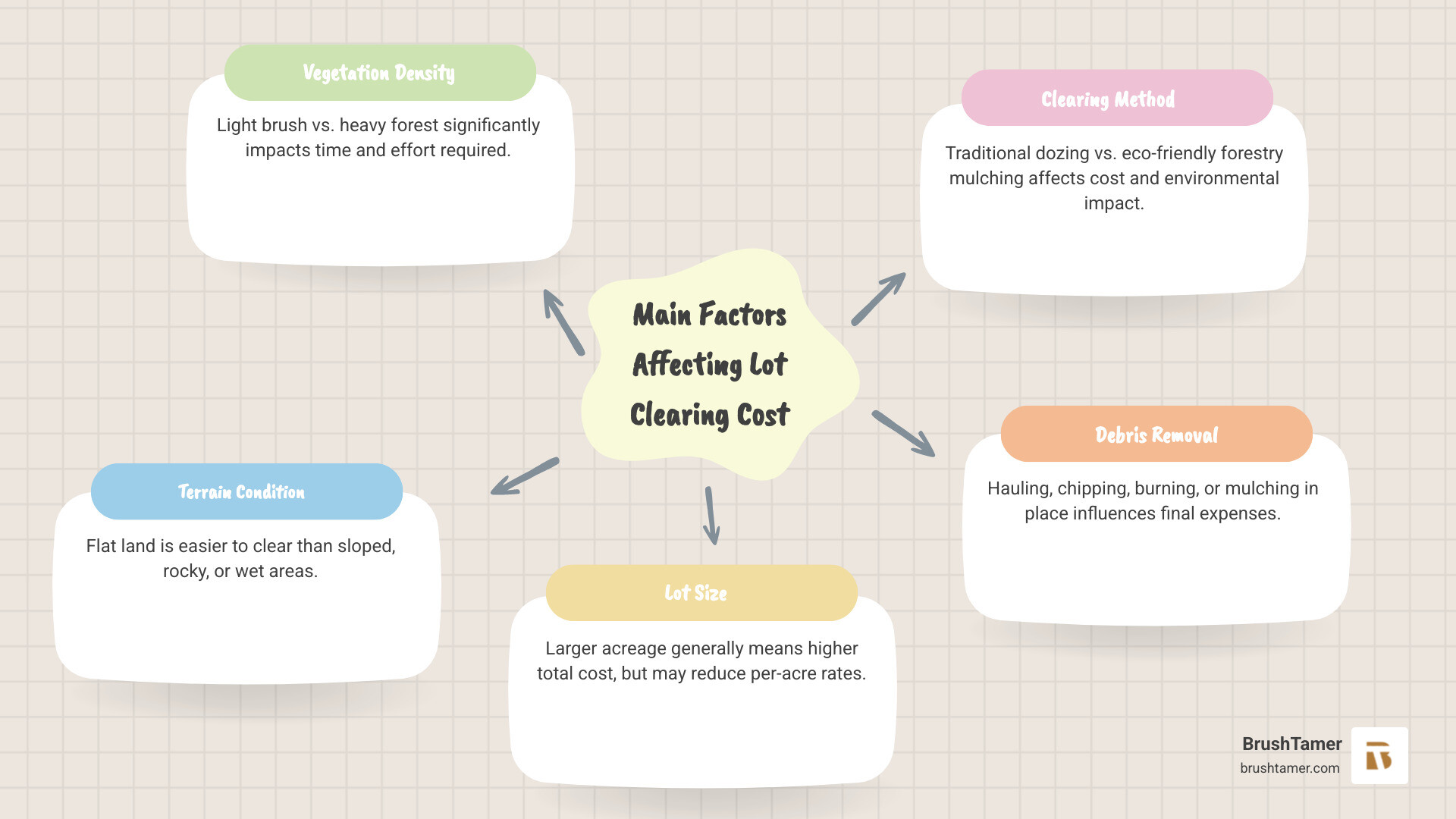
Key Factors That Determine Your Land Clearing Cost
Your land’s unique characteristics are the primary drivers that shape your final lot clearing cost per acre. While the land size provides a baseline for the estimate, factors like vegetation type and density often have a much greater impact on the overall cost. For example, clearing an acre of light brush and small saplings is a fundamentally different task—requiring different equipment, time, and labor—than clearing an acre of mature hardwood trees. The complexity, and therefore the cost, rises with the size and density of the vegetation.
Terrain condition is another critical factor. A flat, dry, and easily accessible property allows machinery to operate at peak efficiency, keeping labor hours and costs down. Conversely, steep slopes, rocky soil, or the presence of streams and wetlands introduces significant complexity. These features may require specialized equipment, such as tracked machines that can handle inclines, and extra safety precautions, all of which add to the project’s duration and expense. If we can’t drive equipment directly to the clearing site, the logistics of getting machinery in and out also affect the estimate. Finally, regional labor rates and the specific equipment needs for your project—from handheld brush cutters and chainsaws to powerful forestry mulchers and excavators—are all calculated into the final price.
More info about our land clearing process
Average Lot Clearing Cost Per Acre by Vegetation Density
Vegetation density is arguably the single most significant factor in determining your lot clearing cost per acre. It dictates the type of equipment needed, the time required, and the volume of debris that must be handled.
Lightly wooded lots are characterized by scattered small trees (typically under 6-8 inches in diameter), saplings, and manageable brush. The clearing process is relatively straightforward and faster, as equipment can move more freely and the volume of resulting debris is lower. A lightly wooded acre might take our professional crew just a few hours to clear using a high-flow skid steer with a mulching attachment.
Heavily forested lots, on the other hand, present a much greater challenge. These areas feature dense canopies, thick undergrowth, and mature trees that can be several feet in diameter. This work demands specialized, heavy-duty equipment for felling, and a careful, strategic approach to ensure safety and efficiency. Clearing a heavily forested acre could require a full day or even multiple days, especially if it involves dealing with numerous large trees and their extensive root systems. The presence of invasive species like buckthorn or honeysuckle can also add to the complexity, as they create a dense, tangled understory that must be removed.
| Vegetation Type | Typical Characteristics | Clearing Complexity | Estimated Cost Range Per Acre |
|---|---|---|---|
| Lightly Wooded | Scattered brush, small saplings (<8″ diameter), open areas | Faster equipment movement, less debris, smaller machinery | $580 – $2,100 |
| Heavily Forested | Dense mature trees (>8″ diameter), thick underbrush, full canopy | Specialized equipment, careful tree removal, significant debris | $3,300 – $5,600+ |
How Land Condition and Terrain Impact the Price
Terrain can dramatically influence the efficiency and safety of a land clearing operation, impacting your lot clearing cost per acre.
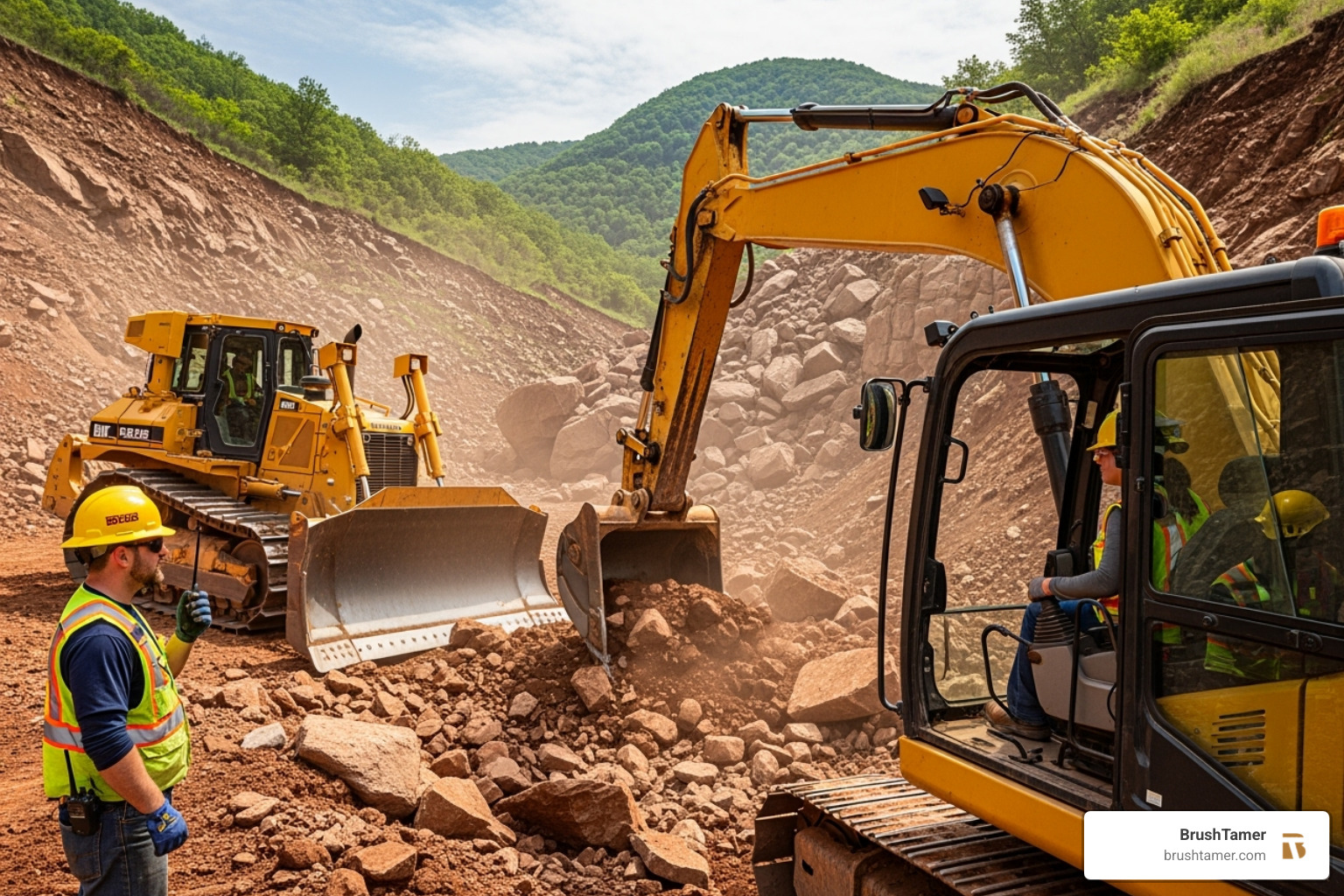
Sloped and Hilly Land: Working on slopes requires specialized tracked equipment for stability and extra safety protocols to prevent accidents, which naturally slows down the process. The steeper the grade, the more time and care are needed.
Soil Type: The composition of your soil matters. Sandy or loamy soil is generally easy to work with. Heavy clay soil, however, can become a sticky, compacted mess when wet, bogging down machinery and making work difficult. Rocky soil not only slows down the work but also increases wear and tear on equipment, and very large rocks and boulders may require an excavator with a breaker attachment to move or break up, adding another layer of cost.
Accessibility: Can a large truck and trailer deliver heavy equipment directly to the site? Narrow access roads, weak bridges, or long distances from a main road can create logistical challenges that add time and cost.
Water Features: The presence of streams, ponds, wetlands, or even seasonal drainage areas requires extreme care. Environmental regulations often mandate setbacks, and special permits are usually required to work near water. This ensures that the clearing process doesn’t lead to erosion or water contamination.
Erosion Control: On any disturbed soil, but especially on slopes or near waterways, erosion control is a critical final step. This may involve immediate seeding, laying down straw blankets, installing silt fences, or creating water bars to manage runoff. These measures are vital for protecting your land and are an important part of the overall project cost.
Debris and Stump Removal Costs
Deciding what to do with the trees, brush, and stumps after they’ve been cut down is a major cost consideration that significantly affects your lot clearing cost per acre.
Hauling: This traditional method involves loading all the debris into dump trucks and hauling it to a landfill or green waste facility. While it leaves the site completely clean, hauling fees and disposal or tipping fees at the facility can be substantial, especially for large volumes of material from a heavily wooded lot.
Wood Chipping or Mulching: A more economical and eco-friendly option is to process the debris on-site. Wood chipping can turn branches and smaller trees into usable chips for landscaping. Forestry mulching (discussed in more detail later) goes a step further by grinding everything, including standing trees, into a nutrient-rich mulch that is spread across the property. This method completely eliminates hauling and disposal costs and provides the added benefit of improving your soil’s health and preventing erosion.
Burning: In some rural areas, piling and burning debris is an option. However, this method is heavily regulated. You will likely need a burn permit, and there are strict rules regarding weather conditions, pile size, and proximity to structures. Due to air quality concerns and fire risk, burning is becoming less common and is not a viable option in many locations.
Stump Removal: Stumps can be handled in two main ways. Stump grinding is the most common approach, using a machine to grind the stump down to several inches below the ground level. This is sufficient for landscaping and creating a lawn. For construction projects, however, root grubbing (complete stump and root ball removal) is often necessary. This is a much more intensive and costly process that requires an excavator and results in significant soil disturbance that will need to be graded afterward.
Comparing Land Clearing Methods: Cost & Benefits
The clearing method you choose is a pivotal decision that significantly impacts your lot clearing cost per acre, the project timeline, and the long-term health of your property. While traditional methods involving bulldozers can effectively create a clean slate, modern techniques like forestry mulching offer a more nuanced, environmentally friendly, and often more cost-effective solution. The best method ultimately depends on your specific property, your budget, and your future plans for the land.
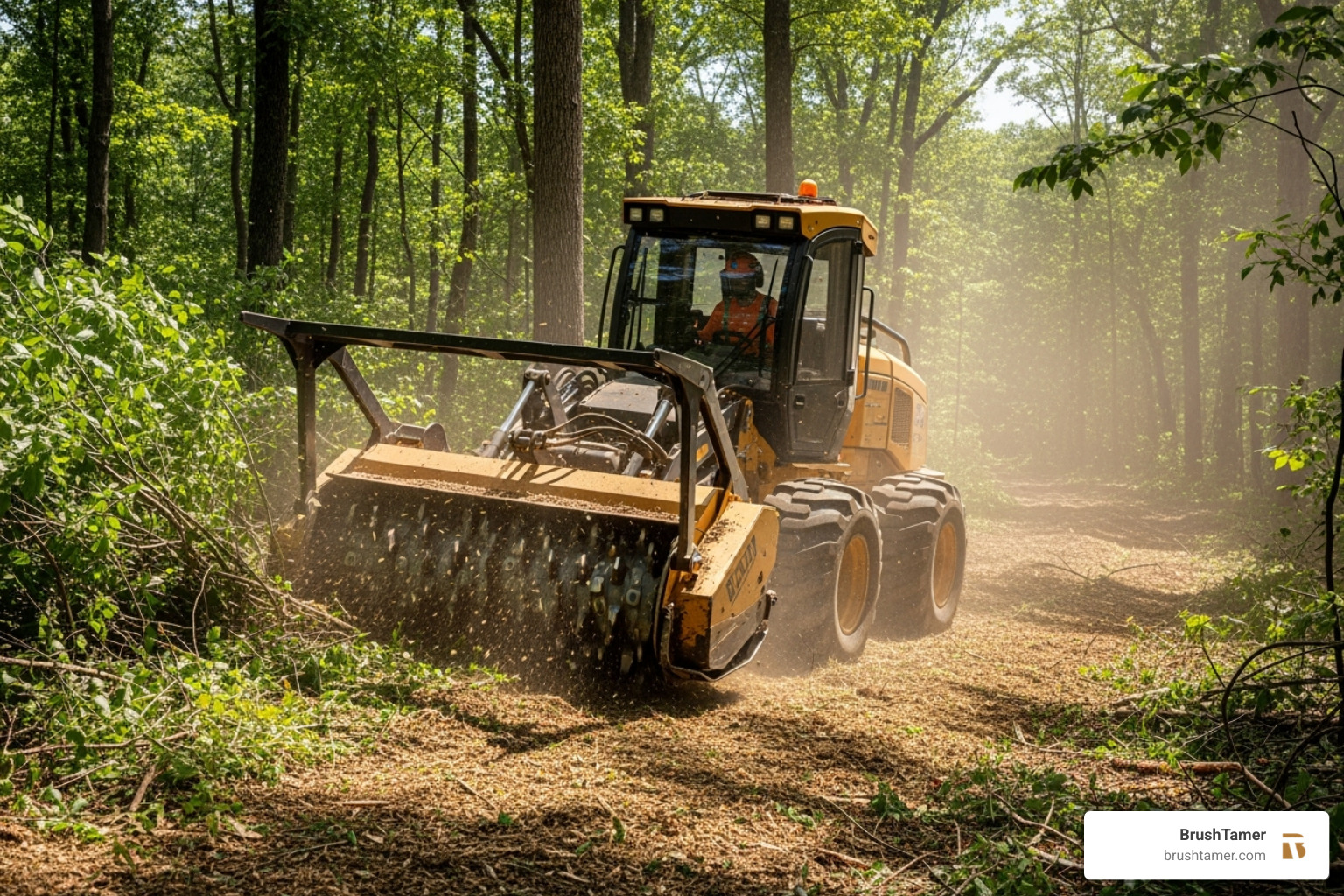
Traditional Clearing: Dozing, Piling, and Hauling
Traditional land clearing is the method many people picture first: using heavy equipment like bulldozers and excavators to push over trees, uproot stumps, and scrape the land clean. The process typically involves several distinct steps:
- Dozing: A bulldozer pushes over trees and brush, moving them across the property.
- Piling: All the cleared vegetation is consolidated into large debris piles (often called burn piles).
- Disposal: The piles must then be dealt with, either by burning (if permits allow) or by loading the material into trucks for disposal.
This is where the costs can escalate rapidly. The combined expense of machine time for piling, plus separate hauling costs and landfill fees, can quickly inflate your budget. Furthermore, this method has significant environmental drawbacks. The heavy machinery scrapes away the nutrient-rich topsoil, leading to severe soil compaction. This compacted, bare earth is highly susceptible to erosion and can take years to recover its fertility. The main benefit of this method is complete clearing, which leaves bare mineral soil ready for immediate construction of foundations or septic systems. However, it comes at a higher price tag and with greater environmental disruption.
Forestry Mulching: An Eco-Friendly and Efficient Alternative
Forestry mulching is a revolutionary, cost-effective, and eco-friendly alternative that has transformed modern vegetation management. This method uses a single machine process. A specialized carrier, such as a high-horsepower skid steer or a dedicated tracked machine, is equipped with a mulching head that features a rotating drum with hardened steel teeth. This single machine moves through the property, grinding trees, brush, and stumps directly where they stand.
The key advantages of forestry mulching are numerous:
- Cost-Effectiveness: By eliminating the need for pushing, piling, and hauling, you also eliminate the associated labor and disposal costs. With no hauling costs or landfill fees, the overall project price is often significantly lower than traditional methods.
- Soil Enrichment: The mulcher grinds vegetation into a fine, nutrient-rich mulch that is deposited directly onto the ground. This mulch layer acts like a natural fertilizer, returning organic matter to the soil. It also helps with soil enrichment, improves water retention, regulates soil temperature, and creates an ideal environment for new grass growth.
- Erosion Control: The layer of mulch immediately protects the soil from wind and water erosion, a critical benefit especially on sloped terrain.
- Selective Clearing: Unlike a bulldozer that clears everything in its path, a skilled operator can use a forestry mulcher to selectively remove unwanted vegetation while preserving desirable mature trees, native plants, and the natural character of your property.
Method Comparison: Which is Right for You?
Choosing between traditional clearing and forestry mulching depends entirely on your end goal.
- Choose Traditional Clearing if: You are preparing a site for a building foundation, a new septic field, or a large-scale agricultural operation that requires bare, graded earth. The complete removal of all organic material and root systems is necessary for these applications.
- Choose Forestry Mulching if: Your goal is to reclaim overgrown pasture, create recreational trails, improve wildlife habitat, manage invasive species, or clear for a home site while preserving the topsoil and select trees. It is the superior choice for projects where soil health and environmental preservation are priorities.
When you factor in the substantial savings on debris disposal and the invaluable long-term benefits to your soil, forestry mulching often emerges as the most cost-effective and environmentally sound choice for the majority of land clearing projects.
Beyond the Acreage Rate: Additional Site Preparation Costs
The quoted lot clearing cost per acre typically covers the removal of vegetation and stumps, but it’s rarely the final expense. To get your land truly ready for its intended use, a series of additional site preparation services are often necessary. These crucial services, including grading and leveling, securing permits, conducting land surveys, and arranging for utility location, form the bridge between a “cleared” lot and a “ready-to-build” site. The scope and cost of this work depend entirely on your project’s goals and the requirements of your local municipality. Understanding these potential costs upfront is essential for creating a comprehensive and realistic budget.
Tax implications of land clearing
Permits, Surveys, and Initial Assessments
These preliminary steps are your insurance policy against costly mistakes, legal troubles, and future structural problems. Skipping them can lead to significant delays, fines, and disputes.
- Permits: Before any heavy equipment arrives, you must check with your local city or county planning department. Many municipalities require permit fees for significant tree removal, grading, or any work near waterways or wetlands. These permits ensure that the work complies with zoning laws, environmental regulations, and safety standards. Failing to secure the proper permits can result in a stop-work order and hefty fines.
- Land Surveys: A professional land survey is crucial for two main reasons. First, it provides property line verification, ensuring that your clearing activities don’t encroach on a neighbor’s land—a mistake that can lead to expensive legal disputes. Second, a topographic survey maps the contours and features of your land, which is essential for planning proper drainage and foundation placement. The land survey cost is a minor investment compared to the potential cost of a boundary dispute or fixing a drainage problem.
- Geotechnical and Soil Assessments: For any construction project, soil testing and geotechnical surveys are highly recommended. These assessments provide essential data on the soil’s composition, stability, and load-bearing capacity. This information is critical for engineers to design a stable foundation and helps you avoid catastrophic surprises, like finding your building site is on unstable or expansive soil.
Final Site Work: Grading, Leveling, and Drainage
After the trees and brush are gone, the land is rarely ready for use. Earthwork and drainage solutions are almost always needed to prepare the site for construction, landscaping, or agriculture.
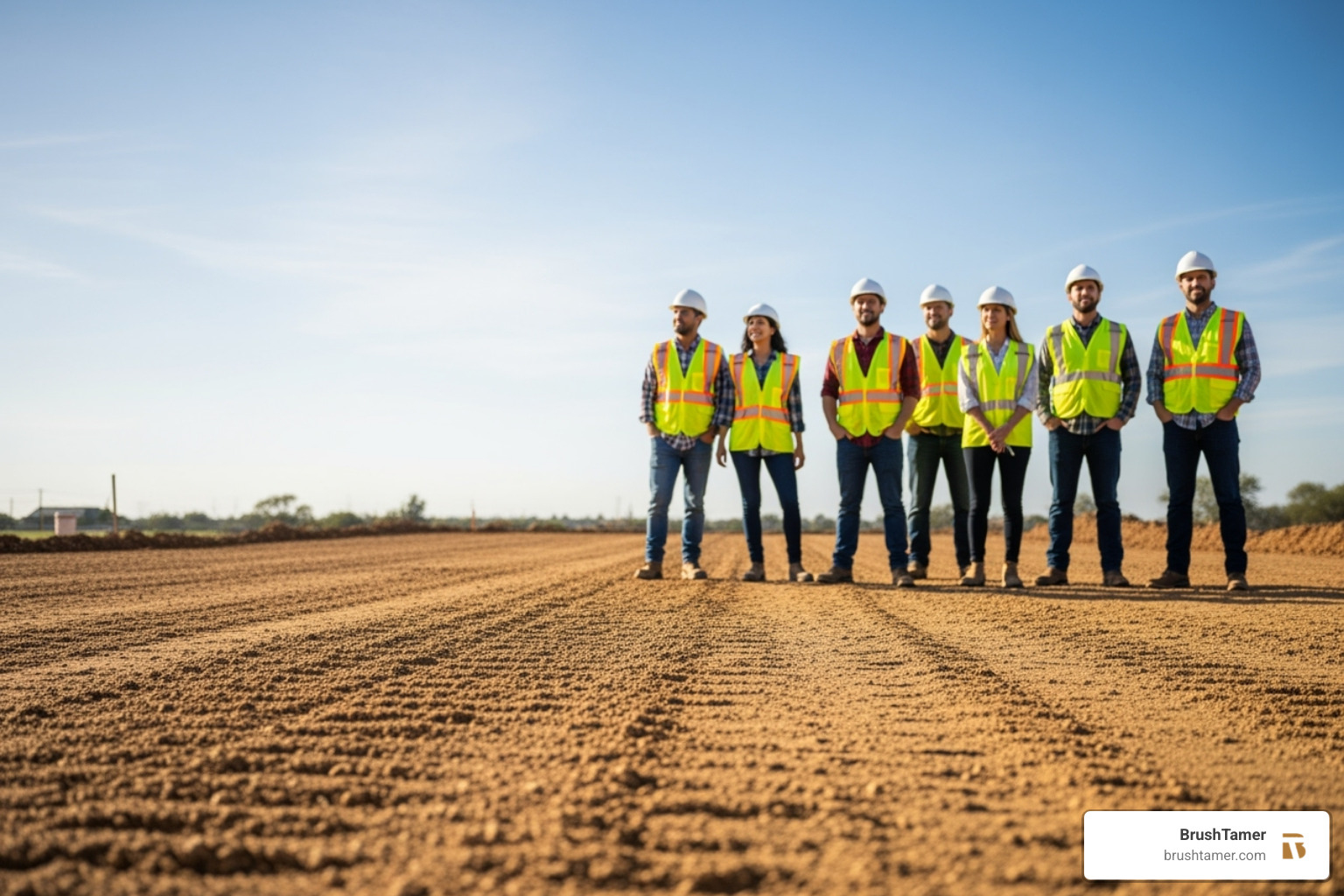
Grading and Leveling: This is the process of reshaping the land’s surface. Rough grading establishes the basic contours of the site, creating level areas (building pads) for structures and shaping slopes to direct water flow away from the building site. Finish grading follows, creating a smooth, precise surface that is ready for pouring a foundation, planting a lawn, or laying a driveway. If the existing soil is of poor quality, the grading process may also involve bringing in fill dirt to build up low areas or adding a layer of topsoil replacement to support healthy landscaping.
Drainage Solutions: This is perhaps the most critical aspect of final site work. Improper drainage can lead to flooded basements, cracked foundations, and swampy yards. Proper drainage solutions are designed to manage stormwater effectively. This can involve creating gentle slopes, digging swales (shallow drainage channels), or installing more complex systems like French drains or culverts to carry water safely away from important areas. This final excavation and earthwork is what transforms your cleared land into a stable, dry, and properly prepared foundation for whatever you plan to build.
Professional Services vs. DIY Land Clearing
When faced with an overgrown lot and calculating the potential lot clearing cost per acre, the idea of a Do-It-Yourself (DIY) project can seem like a tempting way to save money. However, land clearing is not a typical home improvement project. It involves significant safety risks from operating heavy machinery and felling trees, tasks that require specialized training and experience. The potential for serious injury or property damage is high for the inexperienced.
Furthermore, the perceived savings from equipment rental costs can be misleading. Operating heavy machinery like a bulldozer or excavator is a skill that takes time to learn. An inexperienced operator will be far less efficient, leading to longer rental periods and higher fuel consumption. A DIY project that you think will take a weekend can easily stretch into weeks or even months of lost evenings and weekends. In contrast, professionals bring professional efficiency and specialized tools to get the job done quickly and correctly. We also carry full insurance and liability coverage, which protects you, the landowner, from the significant financial consequences of any potential accidents. The hidden expenses of DIY, such as equipment breakdowns, unexpected disposal fees, and navigating complex permit requirements mid-project, often make it a more expensive and stressful route in the long run.
The True Cost of DIY Land Clearing
The sticker price of renting equipment is just the beginning. The true cost of DIY land clearing often includes a long list of unexpected expenses that can quickly add up:
- Equipment Rental: A mid-size bulldozer or excavator can cost $400-$800 per day, plus delivery and pickup fees. You’ll likely need it for more days than you anticipate.
- Additional Tools: You’ll also need to buy or rent chainsaws, axes, safety gear (helmet, chaps, eye and ear protection), and possibly a wood chipper or a large dumpster for debris.
- Fuel and Fluids: Heavy equipment consumes a tremendous amount of diesel fuel, an expense that can easily run into hundreds of dollars.
- Disposal Fees: Dumpster rental and landfill tipping fees for green waste can be surprisingly expensive, often costing several hundred dollars per load.
- Your Time: The biggest hidden cost is the time value of your own labor. Consider how many weekends and evenings you’re willing to sacrifice. What could you be doing with that time instead?
- Physical Toll: Land clearing is backbreaking physical labor. The risk of strain, injury, and pure exhaustion is high.
- Cost of Mistakes: A botched DIY attempt can be incredibly costly to fix. Improperly felled trees can damage property, and incorrect grading can lead to serious drainage issues that require an expert to repair, ultimately costing more than hiring a professional from the start.
Benefits of Hiring a Professional Clearing Company
When you hire a professional company like BrushTamer, you are investing in peace of mind and a guaranteed outcome. The benefits extend far beyond simply getting the job done.
- Experience and Expertise: We’ve cleared hundreds of diverse properties across Indiana, Michigan, Illinois, and Ohio. We know how to handle any challenge, from navigating steep, rocky terrain to selectively clearing around valuable heritage trees. Our skilled professionals operate specialized equipment with precision and efficiency, minimizing damage to the surrounding property.
- Safety and Insurance: Our crew is fully trained in safety protocols, and we are fully insured with liability and workers’ compensation coverage. This completely removes the risk and financial liability from you, the property owner.
- Efficiency and Speed: This is where professionals truly shine. A challenging clearing job that could take a DIYer several weeks of hard labor, we can often complete in a matter of days. We use the right equipment and proven methods to work efficiently, saving you time and hassle.
- Guaranteed, High-Quality Results: We deliver guaranteed results, clearing your land to your exact specifications. We don’t just clear the land; we prepare it for its next purpose, ensuring proper finish and considering long-term factors like soil health and erosion control. Whether your property is near South Bend, Indianapolis, or the Chicago suburbs, we provide reliable, high-quality service with an environmentally responsible approach.
Frequently Asked Questions about Lot Clearing Costs
Here are detailed answers to some of the most common questions landowners have when considering the lot clearing cost per acre.
How long does it take to clear one acre of land?
The time it takes to clear one acre is highly variable and depends on several key factors. For a lightly wooded acre with only scattered brush and small saplings, a professional crew with a forestry mulcher might complete the job in just 2 to 4 hours. However, for a heavily forested acre with dense, mature trees, thick undergrowth, and large stumps that need to be removed, the process can easily take a full day or even two days. Other factors that significantly affect the timeline include:
- Terrain: Steep slopes or rocky ground will slow down machinery and require more careful work.
- Soil Conditions: Wet, muddy soil can bog down equipment and may require waiting for drier conditions.
- Weather: Rain, snow, or high winds can cause delays for safety reasons.
- Equipment Type: The size and type of equipment used play a huge role. A large, dedicated forestry mulcher is much faster than a small skid steer or manual clearing with chainsaws.
- Debris Handling: If debris needs to be hauled away, the time for loading and transport adds to the total project duration.
What is the cheapest way to clear land?
While everyone wants to save money, the “cheapest” method isn’t always the best value in the long run. However, there are several strategies to help reduce your overall costs:
- DIY Brush Removal: For very light work involving only brush and small saplings that you can handle with a chainsaw or heavy-duty mower, doing it yourself can save on labor costs. Be mindful of the safety risks and your own physical limits.
- Sell Valuable Timber: If your property has a significant number of mature, marketable hardwood trees like oak, walnut, or cherry, you may be able to hire a logging company to harvest them. The revenue from the selling valuable timber can significantly offset or even cover the cost of clearing the remaining land.
- Forestry Mulching: This method is often the best overall value. While the hourly rate for the machine might seem high, forestry mulching eliminates the substantial costs of hauling and disposal fees. The long-term benefit of improved soil health and erosion control also adds significant value.
- Phased Clearing: You don’t have to clear your entire property at once. Prioritize the area you need cleared immediately (e.g., for a home site) and clear other sections in later phases as your budget allows.
- Check for Government Grants: For certain projects, especially those focused on conservation or improving agricultural land, government programs may be available. Check with the USDA’s Natural Resources Conservation Service (NRCS) or local conservation districts for potential cost-share programs. Information on tree grants
Does clearing land increase its value?
Yes, in almost all cases, professionally clearing land increases its market value, often by an amount greater than the cost of the clearing itself. The return on investment comes from several areas:
- Improved Access and Usability: Clearing transforms an overgrown, inaccessible parcel into a functional space ready for building, farming, or recreation. This immediately makes it more valuable to a wider range of potential buyers.
- Improved Curb Appeal: An open, well-maintained property is far more attractive than a tangled mess of woods and brush. It boosts curb appeal and makes a much better first impression.
- Demonstrates Construction Readiness: For buyers looking to build, a cleared and graded lot shows that significant prep work is already done, making the property more desirable and signaling that it’s ready for construction.
- Increased Fire Safety: In areas prone to wildfires, creating a defensible space by clearing vegetation around a home site not only improves fire safety but can also lower insurance premiums and add peace of mind, which is a tangible selling point.
- Changes Buyer Perception: A potential buyer looking at an overgrown lot sees a daunting, expensive project. When they see a cleared lot, they see a blank canvas full of possibilities. This shift in buyer perception can lead to quicker sales and higher offers.
What happens to the wildlife on my property during clearing?
This is a responsible and common question. A professional clearing company takes steps to minimize impact. Most smaller animals (raccoons, rabbits, squirrels) and birds will naturally relocate to adjacent wooded areas as the machinery approaches. We conduct a visual inspection for any obvious nests or dens before starting work in a new section. For larger properties, a selective or phased clearing approach can be used to maintain habitat corridors and preserve sensitive areas, allowing wildlife to continue thriving on other parts of your land.
Get a Clear Estimate for Your Midwest Property
Planning a land clearing project can feel overwhelming, especially when trying to budget for it. As we’ve detailed, the lot clearing cost per acre isn’t a simple, off-the-shelf number. It’s a custom calculation that reflects the unique story of your property. A heavily wooded acre on a slope in Michigan presents entirely different challenges and costs than a flat, brush-covered lot in central Illinois. This is precisely why a generic online cost calculator is often misleading and why a professional, on-site assessment is a crucial first step.
The most important action you can take is to get a detailed, professional quote from an experienced contractor. A thorough estimate should do more than just give you a price; it should break down the recommended services, explain the equipment to be used, and clearly outline how your specific site conditions (like terrain, soil, and vegetation density) influence the cost and the project timeline. This transparency empowers you to make a truly informed decision without any hidden surprises.
At BrushTamer, we don’t just clear land; we focus on understanding your land’s potential and helping you achieve your vision for it. Our process begins with a conversation. We walk the property with you, listening to your goals. Do you want to build a home? Create pasture for horses? Develop a network of ATV trails? Your objective determines our strategy. Our team brings years of experience navigating diverse Midwest land conditions, from the soggy soils near the Great Lakes to the rocky, hilly terrain of Southern Indiana. We understand the local ecosystems and the municipal regulations that can impact your project.
Our on-site assessment is comprehensive. We will:
- Identify the types and density of vegetation.
- Assess the terrain, soil conditions, and accessibility.
- Note any sensitive areas, such as waterways or desirable heritage trees to be preserved.
- Discuss the pros and cons of different clearing methods, like forestry mulching versus traditional clearing, for your specific situation.
- Explain the debris and stump removal options.
Based on this assessment, we provide a clear, itemized estimate. Getting started is simple. A professional assessment removes the guesswork, provides a firm budget, and clarifies the exact steps needed to bring your vision to life. We are committed to delivering reliable, efficient, and environmentally responsible results that protect your property and improve its value for years to come.
Contact us for a free, detailed estimate on your land clearing project
